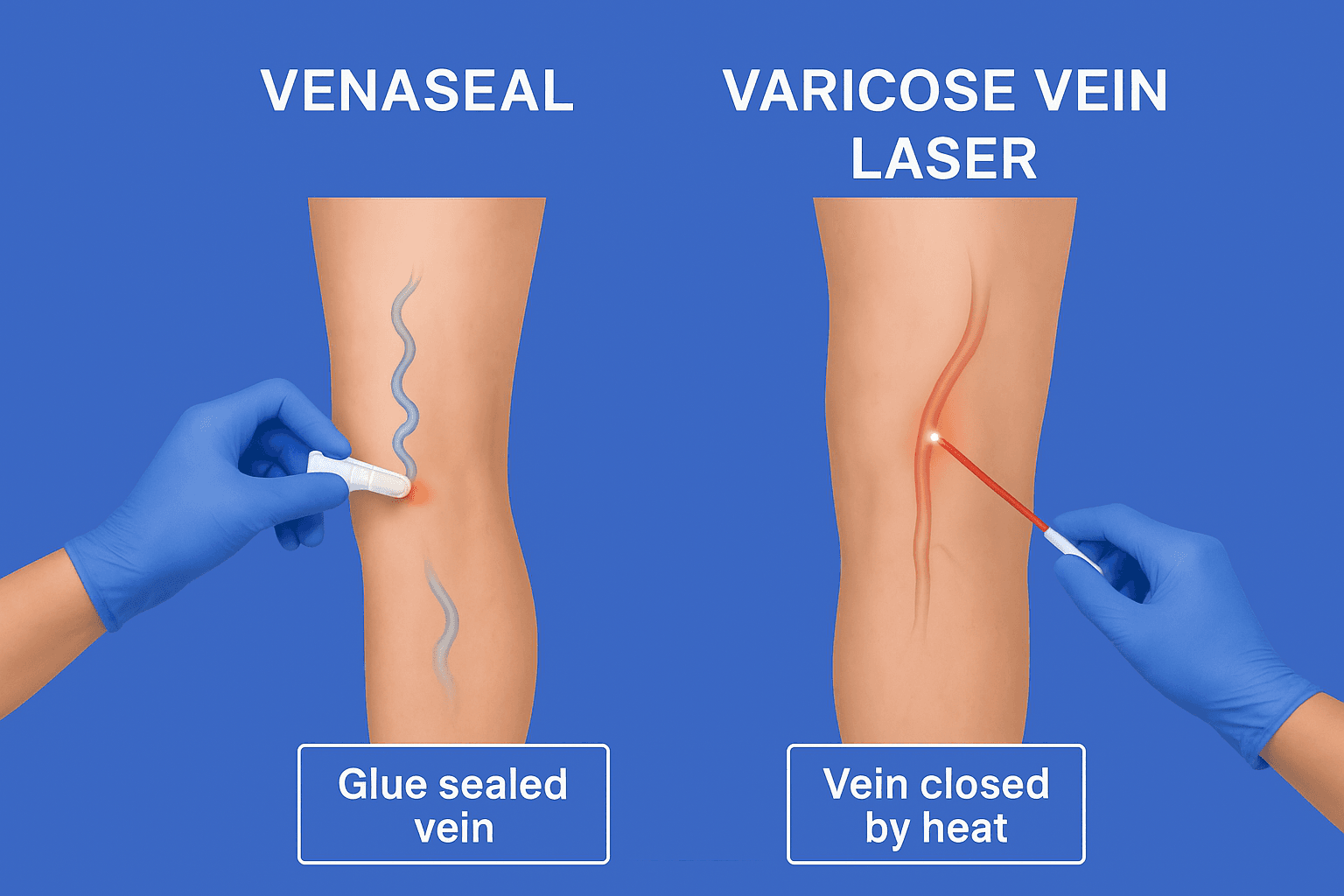If you are dealing with varicose veins, you know that the heavy, aching sensation and visible rope-like structures on your legs can be more than just a cosmetic nuisance—they are a sign of underlying vein disease. Fortunately, the days of lengthy recovery following traditional vein stripping surgery are over. Today, two advanced, minimally invasive procedures dominate the field: Endovenous Laser Ablation (EVLA), commonly referred to as “Laser,” and the VenaSeal Closure System, also known as the “Glue” technique.

Choosing between the two can feel complex. While both methods are highly effective and share core similarities in their modern approach, they differ significantly in their mechanism, recovery profile, and cost. Understanding these distinctions is key to selecting the right varicose veins treatment for your specific needs.
The Essentials They Share: Minimally Invasive Excellence
Both Laser and VenaSeal represent the gold standard in modern vein care. Their common attributes demonstrate a significant departure from older surgical methods:
- No Major Surgery: Both treatments bypass the need for large incisions, cuts, or stitches. The entire procedure is performed using a single, tiny puncture site, allowing for rapid patient mobilization.
- Advanced and Focused: Both are considered high-tech methods used to treat the root cause of the problem: the main feeder vein, typically the Great or Short Saphenous Vein. It is important to note that any smaller, visible surface varicosities often require a supplemental treatment, such as Sclerotherapy or hook removal, regardless of which main vein technique is used.
- Fast Recovery: Because of their minimally invasive nature, both treatments allow patients to leave the facility quickly, often within hours, and return to normal, non-strenuous activities almost immediately.
The Core Difference: Thermal Energy Versus Medical Adhesive
The two procedures diverge dramatically in how they achieve vein closure, impacting the patient’s experience during and after the treatment:
1. Endovenous Laser Ablation (EVLA): The Heat Seal
EVLA utilizes thermal energy to close the vein. A small fiber is inserted into the diseased vein and, upon activation, delivers heat to the vein wall. This concentrated thermal energy causes the vein to collapse, seal shut, and eventually dissolve into the body.
Because the heat poses a risk to surrounding tissue, a protective step is required: Tumescent Anesthesia. This involves injecting a large volume of dilute local anesthetic solution around the vein. While effective in safeguarding the tissue, these injections are what primarily contribute to the mild post-procedure swelling, discomfort, and bruising often associated with laser treatment.
2. VenaSeal Closure System: The Instant Glue Seal
VenaSeal is recognized as a non-thermal ablation method because it generates no heat. Instead, it uses a medical-grade super-adhesive, or glue, delivered via a specialized catheter. Once the adhesive is placed, the surgeon applies light external compression, instantly sealing the walls of the vein together.
Since there is no heat and no large volume of injections needed, VenaSeal significantly reduces the inflammation seen with thermal procedures. Consequently, patients often report less post-procedure pain and swelling.
Key Differentiators in Recovery and Cost
The mechanism of action creates several practical differences that patients weigh when deciding on a treatment:
| Comparison Feature | Varicose Vein Laser (EVLA) | VenaSeal (Glue) |
| Compression Stockings | Required. Typically advised for up to two weeks to help control swelling and bruising caused by the heat and tumescent fluid. | Generally Not Required for the treated main vein, due to the immediate mechanical seal of the adhesive. |
| Procedural Cost | Lower overall cost. While a disposable fiber is used, the main laser machine is a shared capital cost. | Significantly Higher Cost. The entire system (catheter, glue, delivery) is consumable and very expensive, making the procedure costlier. |
| Unique Risks | Temporary, mild hardness or tenderness along the treated vein segment is common. | A rare (but possible) complication is an allergic or hypersensitivity reaction to the glue (adhesive). |
Making the Right Choice
Neither Laser nor VenaSeal is universally superior; the “best” technique is the one that is optimized for your individual medical and financial circumstances.
If avoiding compression stockings is a high priority and cost is not a factor, VenaSeal may be appealing. If you prefer a highly proven, cost-effective treatment with decades of clinical data, and don’t mind wearing compression stockings for a couple of weeks, EVLA is an excellent choice.
The most valuable step you can take is to consult a specialist, such as a Vascular & Interventional Radologist who is experienced with both EVLA and VenaSeal, to assess your specific vein anatomy and guide you toward the ideal Varicose Veins Treatment.





